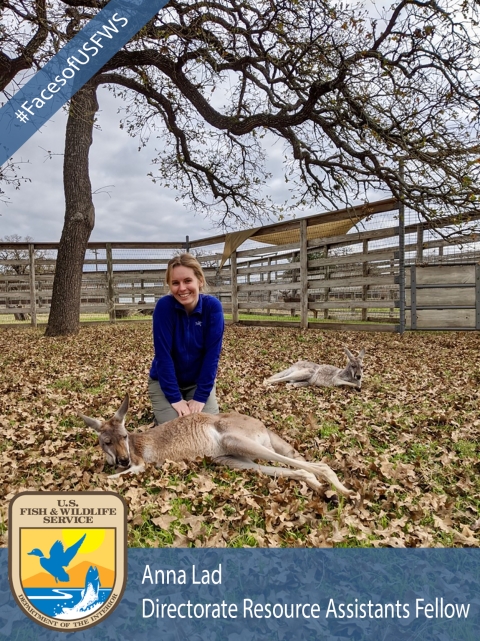By Olivia Beitelspacher, public affairs specialist
Meet one of our newest DFP interns Anna Lad! Anna discusses her conservation heroes and the experiences that helped shape her passion for conservation. Learn more about Anna in the latest Faces of the U.S. Fish and Wildlife Service interview.
Olivia Beitelspacher: Welcome to the U.S. Fish and Wildlife Service Anna! We’re happy to have you with us. Can you tell us how you found out about the DFP program and what project you’ll be doing this summer?
Anna Lad: Howdy! I discovered the internship via my graduate program advisor. This summer, I’ll be mapping the habitat and range of the endangered Smith’s blue butterfly.
OB: Wow! Sounds like an amazing and important project. Are you still in school? And if yes, what are you studying?
AL: Yes, I’m still in school – only one more semester to go until I get my M.S. in Science & Technology Journalism from Texas A&M. My B.S. is in Wildlife and Fisheries Sciences, also from Texas A&M.
OB: You’re so close! The finish line is within sight. So Anna, do you have any conservation heroes?
AL: My conservation hero is a woman whose work illuminated insect life-cycles at a time when people still believed insects spawned from mud. Maria Sibylla Merian was a German naturalist and prolific scientific illustrator in the late 1600s. At just 13, she began painting and drawing insects she captured around her home and garden. Her tenacity and dedication to her craft are inspirational. She and her daughter went on an insect-classifying voyage to South America in a time when it was rare for women to even know how to read!
OB: She sounds like a truly inspirational woman! I’ll definitely need to learn more about her. Is there a particular project that you’ve been involved with that you are particularly proud of the outcome?
AL: On a study abroad, I helped researchers capture and photograph a sea turtle. The pictures would be used to create the first reptile and amphibian encyclopedia of Ecuador. I played a small role, but it was an honor to be a part of.
OB: What a special project to be a part of! I’d love to hear more about your experience with sea turtles. But for now, here’s the last questions: What is the coolest plant or animal that you protect, conserve, restore, or educate about?
AL: In my senior year of college, I was an ostrich keeper for Texas A&M’s Wildlife Center. I learned so much about ostriches, peacocks, kangaroos, and other exotic animals. Every species is unique, and each has something to bring to the table.
OB: What a unique job! I bet you learned a lot and made some amazing memories. Thank you Anna!




